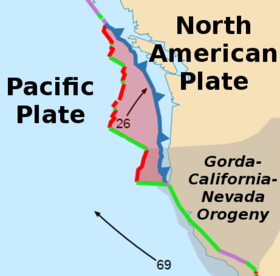Juan de Fuca Plate
| Juan de Fuca Plate | |
|---|---|
 |
|
| Type | Minor |
| Approximate area | 250,000 km2 (96,000 sq mi) |
| Movement1 | north-east |
| Speed1 | 26mm/year (1.0 in/yr) |
| Features | Pacific Ocean |
| 1Relative to the African Plate | |
The Juan de Fuca Plate is a tectonic plate generated from the Juan de Fuca Ridge and is subducting under the northerly portion of the western side of the North American Plate at the Cascadia subduction zone. It is named after the explorer of the same name. One of the smallest of Earth's tectonic plates, the Juan de Fuca Plate is a remnant part of the once-vast Farallon Plate, which is now largely subducted underneath the North American Plate.
The Juan de Fuca plate system has its origins with Panthalassa's oceanic basin and crust. This oceanic crust has primarily been subducted under the North American plate, and the Eurasian Plate. Panthalassa's oceanic plate remnants are understood to be the Juan de Fuca, Gorda, Cocos and the Nazca plates, all four of which were part of the Farallon Plate.
The Juan de Fuca plate is bounded on the south by the Blanco Fracture Zone (running northwest off the coast of Oregon), on the north by the Nootka Fault (running southwest off Nootka Island, near Vancouver Island, British Columbia) and along the west by the Pacific Plate (which covers most of the Pacific Ocean and is the largest of Earth's tectonic plates). The Juan de Fuca plate itself has since fractured into three pieces, and the name is applied to the entire plate in some references, but in others only to the central portion. The three fragments are differentiated as such : the piece to the south is known as the Gorda Plate and the piece to the north is known as the Explorer Plate. The separate pieces are demarcated by the large offsets of the undersea spreading zone.
...
Wikipedia
